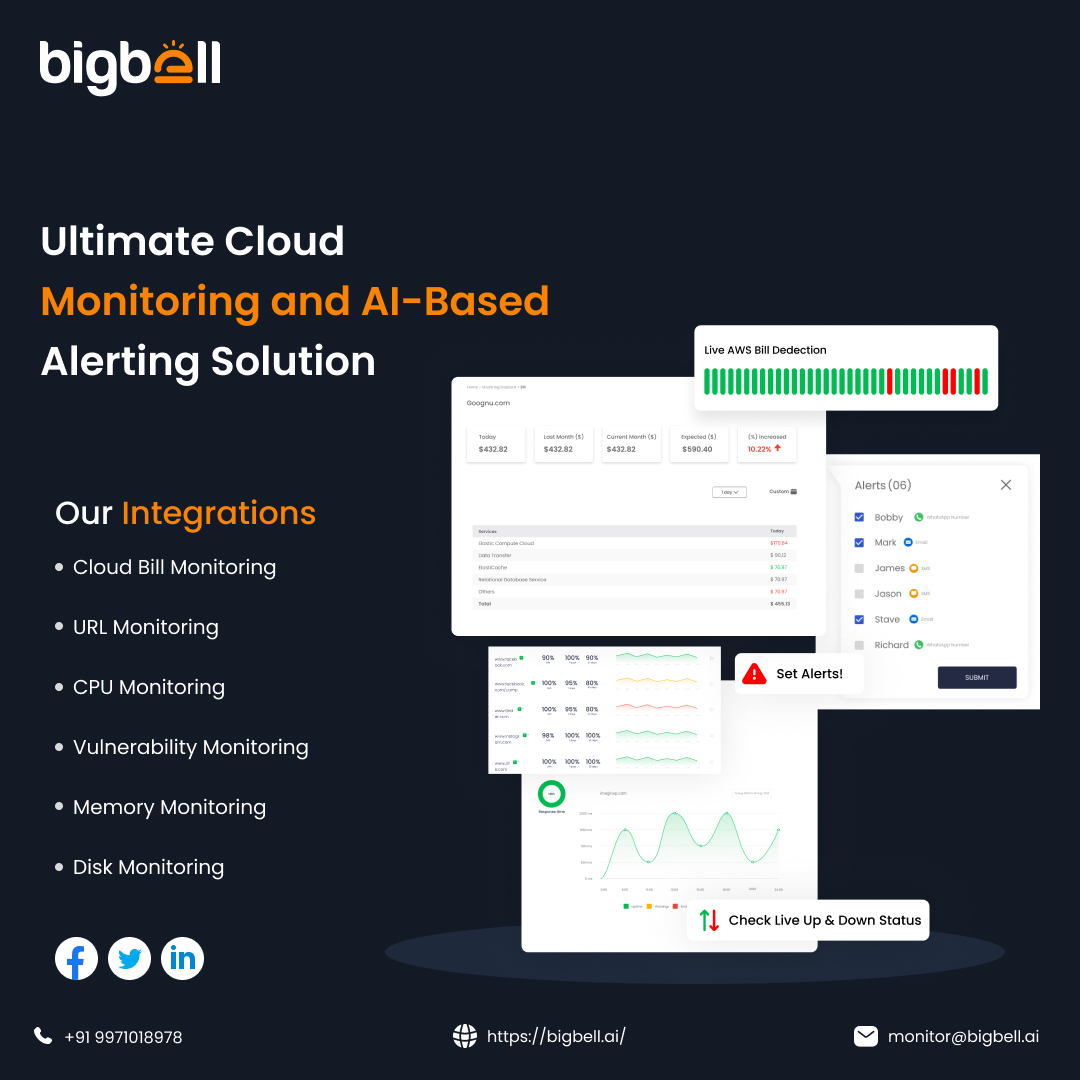Introduction to monitoring services
In today’s fast-paced and competitive business environment, staying ahead of the curve is crucial for success. One of the key factors that can make or break a business is its ability to monitor and manage its operations effectively. This is where reliable monitoring services come into play. A monitoring service is a vital tool that allows businesses to keep a close eye on their systems, networks, and applications, ensuring that they are running smoothly and efficiently.
The role of monitoring services in business success
Monitoring services play a pivotal role in the overall success of a business. By providing real-time insights into the performance and health of various aspects of a business’s operations, these services enable businesses to proactively identify and address any issues before they escalate into major problems. Whether it’s monitoring the uptime and response time of a website, tracking the performance of a cloud infrastructure, or keeping an eye on network security, a reliable monitoring service acts as a crucial early warning system, allowing businesses to take timely and informed actions to mitigate any potential risks.
Benefits of using a reliable monitoring service
Using a reliable monitoring service offers numerous benefits for businesses of all sizes. Firstly, it helps in ensuring the smooth and uninterrupted operation of critical systems and applications, minimizing downtime and maximizing productivity. This, in turn, leads to enhanced customer satisfaction and loyalty. Additionally, monitoring services provide businesses with valuable insights and data that can be used to optimize performance, improve efficiency, and make informed decisions. By monitoring key metrics such as response time, resource utilization, and error rates, businesses can identify bottlenecks, optimize workflows, and allocate resources effectively, ultimately leading to cost savings and improved profitability.
Different types of monitoring services
Cloud monitoring service
As businesses increasingly rely on cloud-based infrastructure and services, cloud monitoring has become an essential component of any monitoring strategy. A cloud monitoring service enables businesses to monitor the performance, availability, and security of their cloud resources, ensuring that they are meeting the agreed-upon service level agreements (SLAs). By monitoring key parameters such as CPU usage, memory utilization, and network latency, businesses can identify and address any issues that may impact the performance and availability of their cloud-based applications and services.
URL monitoring service
For businesses that rely heavily on their websites and online platforms to reach and engage with customers, a URL monitoring service is a must-have. This type of monitoring service continuously monitors the availability and response time of a website or web application from multiple locations, ensuring that it is accessible and responsive to users across different geographical regions. By detecting and alerting businesses to any website downtime or performance issues, a URL monitoring service helps in maintaining a positive user experience, preventing revenue loss, and protecting brand reputation.
Remote monitoring services
Remote monitoring services enable businesses to monitor and manage their IT infrastructure and assets remotely, without the need for physical presence. This type of monitoring service is particularly valuable for businesses with multiple locations or those with a distributed workforce. By remotely monitoring servers, network devices, and endpoints, businesses can ensure that their IT systems are operating optimally and performing at their best. Remote monitoring services also provide businesses with the flexibility to respond quickly to any issues and perform necessary maintenance and troubleshooting tasks without the need for on-site visits.
How to choose the right monitoring service for your business
Choosing the right monitoring service for your business can be a daunting task, given the wide range of options available in the market. However, by considering a few key factors, you can make an informed decision that aligns with your business needs and objectives.
Firstly, identify the specific areas and aspects of your business that require monitoring. This could include your website, cloud infrastructure, network, applications, or a combination of these. Once you have a clear understanding of your monitoring requirements, evaluate the features and capabilities offered by different monitoring services. Look for features such as real-time monitoring, customizable alerts, comprehensive reporting, and integration with other tools and platforms. Additionally, consider factors such as scalability, ease of implementation, and customer support.
It is also important to consider the reliability and reputation of the monitoring service provider. Look for providers with a proven track record and positive customer reviews. Consider their experience in your industry and their ability to meet your specific monitoring needs. Finally, don’t forget to factor in your budget. While it’s important to invest in a reliable monitoring service, it’s equally important to ensure that the cost aligns with your business’s financial capabilities.
Key features to look for in a monitoring service
When choosing a monitoring service for your business, there are several key features that you should look for to ensure you get the most out of your investment.
-
Real-time monitoring: The ability to monitor your systems and applications in real-time is crucial for timely detection and resolution of any issues. Look for a monitoring service that offers real-time monitoring capabilities, providing you with instant visibility into the performance and health of your critical assets.
-
Customizable alerts: Different businesses have different monitoring requirements and thresholds. Look for a monitoring service that allows you to set customized alert conditions and notifications. This ensures that you are only alerted when a specific condition or threshold is met, reducing unnecessary noise and false positives.
-
Comprehensive reporting: A good monitoring service should provide you with comprehensive and easy-to-understand reports and dashboards. Look for features such as historical data analysis, trend analysis, and customizable reporting options. This will enable you to gain valuable insights into the performance and trends of your systems and make informed decisions.
-
Integration capabilities: Consider the monitoring service’s ability to integrate with other tools and platforms that you use in your business. Seamless integration allows for better collaboration and automation, streamlining your monitoring and management processes.
-
Scalability: As your business grows, your monitoring needs will likely evolve. Look for a monitoring service that is scalable and can accommodate your future requirements. This will ensure that your investment in a monitoring service is future-proof and can grow with your business.
Case studies of businesses that have benefited from monitoring services
To illustrate the real-world impact of monitoring services on business success, let’s take a look at a couple of case studies.
Case Study 1: Company X
Company X is an e-commerce platform that relies heavily on its website for generating revenue. They experienced frequent website downtime and slow response times, resulting in a loss of sales and customer dissatisfaction. By implementing a URL monitoring service, Company X was able to proactively identify and address any website performance issues. This led to a significant reduction in website downtime and improved overall customer experience. As a result, Company X saw a substantial increase in sales and customer retention.
Case Study 2: Company Y
Company Y is a software development company that operates in a highly competitive market. They needed a reliable monitoring service to ensure the optimal performance and availability of their cloud-based applications. By implementing a cloud monitoring service, Company Y was able to track key performance metrics, identify performance bottlenecks, and optimize resource allocation. This resulted in improved application performance, reduced customer complaints, and increased customer satisfaction. Company Y was also able to make data-driven decisions to optimize their cloud infrastructure, leading to cost savings and improved profitability.
Common challenges in implementing a monitoring service and how to overcome them
Implementing a monitoring service in a business environment can come with its fair share of challenges. However, with proper planning and execution, these challenges can be overcome. Here are some common challenges and strategies to tackle them:
-
Lack of clarity on monitoring requirements: Before implementing a monitoring service, it’s crucial to have a clear understanding of your monitoring needs. Define the specific areas and aspects of your business that require monitoring, and establish clear monitoring objectives and metrics.
-
Choosing the right monitoring service provider: With numerous monitoring service providers in the market, choosing the right one can be overwhelming. Take the time to research and evaluate different providers based on their reputation, experience, and customer reviews. Consider scheduling demos or trials to assess the usability and suitability of the monitoring service.
-
Integration with existing systems and tools: Integrating a monitoring service with existing systems and tools can be a challenge. Ensure that the monitoring service you choose offers seamless integration capabilities and provides clear documentation and support for integration.
-
Managing alert fatigue: Constantly monitoring and receiving alerts can lead to alert fatigue, where genuine issues may be overlooked or ignored due to the overwhelming number of alerts. Establish clear alert criteria and thresholds, and regularly review and fine-tune them to minimize unnecessary noise.
-
Ensuring data privacy and security: When implementing a monitoring service, it’s important to ensure the privacy and security of your data. Choose a monitoring service provider that has robust security measures in place, including data encryption, access controls, and compliance with relevant regulations.
Best practices for using a monitoring service effectively
To maximize the benefits of a monitoring service, follow these best practices:
-
Define clear monitoring objectives: Clearly define the specific objectives and metrics you want to monitor. This will help you focus your monitoring efforts and ensure that you are monitoring the right aspects of your business.
-
Regularly review and fine-tune monitoring thresholds: As your business evolves, so will your monitoring needs. Regularly review and fine-tune your monitoring thresholds to ensure they align with your business objectives and changing requirements.
-
Establish a proactive monitoring and response strategy: Use the insights provided by your monitoring service to proactively identify and address any issues before they impact your business. Establish clear escalation and response procedures to ensure timely resolution of any issues.
-
Leverage automation and integration: Take advantage of automation and integration capabilities offered by your monitoring service. This will help streamline your monitoring and management processes, improve efficiency, and reduce manual effort.
-
Regularly analyze and interpret monitoring data: Monitoring data is only valuable if it is analyzed and interpreted effectively. Regularly review your monitoring reports and dashboards, and look for trends and patterns that can provide insights into the performance and health of your systems. Use this data to make informed decisions and optimize your business operations.
Conclusion: The importance of investing in a reliable monitoring service for long-term business success
Investing in a reliable monitoring service is not just a good practice; it is essential for the long-term success of any business. A monitoring service acts as an early warning system, providing businesses with real-time insights into the performance and health of their critical assets. By proactively monitoring and managing systems, networks, and applications, businesses can ensure smooth operations, minimize downtime, and maximize productivity. With the right monitoring service in place, businesses can optimize performance, improve efficiency, and make informed decisions based on data-driven insights. So, don’t overlook the importance of a reliable monitoring service – it could be the key to unlocking your business’s full potential.
CTA: Visit Bigbell to explore our reliable monitoring services and take your business to new heights of success.





